Brent Marchant's Blog, page 76
August 15, 2019
‘Mike Wallace Is Here’ charts the quest for one’s calling
“Mike Wallace Is Here” (2019). Cast: Mike Wallace, Morley Safer, Steve Kroft, Don Hewitt, Barbara Walters, Ed Bradley, Lesley Stahl, Dan Rather, Harry Reasoner, Chris Wallace, Bill O’Reilly, Larry King, Walter Cronkite, Edward R. Murrow, Oprah Winfrey, Dick Cavett, Jacqueline Kennedy, John F. Kennedy, Dr. Martin Luther King Jr., Malcolm X, Salvador Dali, Eldon Edwards, Eleanor Roosevelt, Frank Lloyd Wright, Rod Serling, Jack Benny, Johnny Carson, Bette Davis, Kirk Douglas, Billie Holiday, Shirley MacLaine, Barbra Streisand, Arthur Miller, Richard Nixon, Spiro Agnew, John Ehrlichman, Donald Trump, Leona Helmsley, William Westmoreland, John McCain, Ayatollah Khomeini, Vladimir Putin, Anwar Sadat, Jeffrey Wigand. Director: Avi Belkin. Web site. Trailer.
Finding one’s calling in life is often challenging enough, but, in an emerging industry or profession, it can be that much more difficult. Pioneers in such endeavors frequently require some time to find their footing and their voice, generally going through a process of trial and error to find the right fit. Some won’t succeed and will move on to different ventures, but others are fortunate enough to come up with the right mix that suits their needs and those who they serve. So it was for an aspiring newsman in the early days of television, a journalist who went on to become a legend in his own time, a story told in the engaging new documentary, “Mike Wallace Is Here.”
Virtually anyone who watched television in the last few decades of the 20th Century knows the name Mike Wallace (1918-2012). The intrepid, no-nonsense, hard-hitting interviewer of everyone from celebrities to kings made quite a name for himself at CBS News, primarily through his work on the groundbreaking news magazine 60 Minutes. But such success was far from instantaneous.
As the documentary shows, Wallace took some time to find his voice. In the early days of TV, he recalls, those who worked in the field did a little bit of everything, from newscasts to talk shows to commercials to hosting or participating as panelists on game shows. Given this diverse range of job requirements and responsibilities, TV professionals of the time often had to grope their way through the flotsam to discover what best suited them. And, for Wallace, commercials and game shows didn’t cut it.
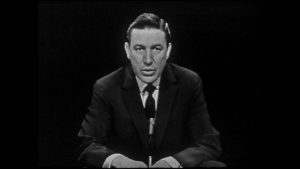
Beginning with the live late night interview show Night Beat in the 1950s, legendary broadcaster Mike Wallace developed his talent for asking probing questions, as seen in the engaging new documentary, “Mike Wallace Is Here.” Photo courtesy of Magnolia Pictures.
Wallace got his first glimpse of what he wanted to do in 1956, when he was tapped to host a live late night interview show called Night Beat (later renamed The Mike Wallace Interview). Through this largely one-on-one interview format, Wallace had conversations with a wide range of luminaries in politics, activism, entertainment and the arts. It gave him a chance to interview some of the living icons of his time, such as architect Frank Lloyd Wright, former First Lady Eleanor Roosevelt, abstract artist Salvador Dali and Twilight Zone creator Rod Serling. But it also was here that he cut his teeth on asking probing questions, as seen, for example, in an often-tense conversation with Ku Klux Klan leader Eldon Edwards.
Despite his emergence as a skilled interviewer, Wallace’s career came to an abrupt halt in 1962, when his son Peter was killed in a mountain-climbing accident in Greece. In the wake of this incident, and with his interview show having completed its run, Wallace went through an intense period of introspection. Having come to the realization that life is not guaranteed, Wallace realized that he wanted to take charge of his life and career, focusing his attention on what he really wanted to do most, the kind of penetrating interviews at which he had become proficient.
Wallace joined the staff of CBS News, a somewhat daunting move for him in light of the network’s long-standing reputation for scrupulous journalistic excellence. Wallace found it intimidating given his lack of formal training and suddenly finding himself working alongside such broadcasting legends as Walter Cronkite and Edward R. Murrow. Seeing himself as something of an outsider who needed to prove himself, Wallace worked diligently to establish himself as a credible reporter, one worthy of being part of the ranks at CBS.

Journalist Mike Wallace (left) interviews Ku Klux Klan leader Eldon Edwards (right) during an episode of the pioneering late night interview show Night Beat, as seen in director Avi Belkin’s new documentary, “Mike Wallace Is Here.” Photo courtesy of Magnolia Pictures.
Wallace’s career-changing break came in 1968, when he teamed up with producer Don Hewitt and fellow correspondent Harry Reasoner to create 60 Minutes, an experimental television news magazine. The format and content were unlike anything else on the air, and even the trio of creators had no clear idea of what they wanted the show to be in its early days. They tried doing many different kinds of stories, approaches that were seen as inventive and revolutionary. But, despite such critical acclaim, the series was a ratings flop, nearly always coming at the bottom of the list of network shows and constantly on the verge of cancellation.
Fortunes turned around in the wake of the Watergate break-in. Having covered Richard Nixon’s presidential campaign, Wallace knew all of the principals in the White House – and who were caught up in the scandal. Such access enabled 60 Minutes to do a number of stories related to the incident, such as a telling interview with White House counsel John Ehrlichman, all of which helped give the show a huge bump in ratings. At last the program had found its legs and was now ready to run.
In the ensuing years, Wallace and fellow hosts Dan Rather and Morley Safer helped cement the show’s reputation as a television staple, eventually becoming the top-rated series on the air, quite a coup for a news-based program. In addition to its political stories, 60 Minutes conducted investigative reporting segments, insightful pieces about science and technology, probing interviews with world leaders like Egyptian President Anwar Sadat, Russian President Vladimir Putin and Supreme Iranian Leader Ayatollah Khomeini, and celebrity interviews with the likes of Johnny Carson, Barbra Streisand, Bette Davis, Oprah Winfrey and Shirley MacLaine. Wallace even conducted an interview with an up-and-coming real estate developer named Donald Trump who, ironically enough, claimed to have no interest in politics.

During a classic 60 Minutes segment, journalist Mike Wallace (right) interviews an up-and-coming brash new real estate developer named Donald Trump (left), as seen in the engaging new documentary “Mike Wallace Is Here.” Photo courtesy of Magnolia Pictures.
Through his work, Wallace became synonymous with hard-hitting journalism. In fact, many of those who followed in his footsteps claimed that he served as their model for this style of reporting, an observation offered, for example, by former Fox News commentator Bill O’Reilly during an interview, ironically enough, conducted by Wallace himself.
But, while Wallace was largely credited with turning the journalistic exposé into an art form, he was also criticized for a certain degree of sensationalism. While he didn’t succumb to the bombastic style of many of those who followed him, he was nevertheless censured by some who claimed that he frequently exhibited qualities more readily associated with showmanship than with journalistic objectivity. The jury is still out on that one, but this criticism came up more than once and has managed to modestly but persistently cling to his legacy.
It’s interesting to note that, when the tables were turned on Wallace, he was not as candid with those who interviewed him as his subjects often were with him. In interviews with colleagues Barbara Walters and Morley Safer, for example, Wallace frequently holds back, answering questions with questions or deflecting the inquiries asked of him. For instance, in clips from such conversations, he’s reluctant to speak about subjects like his lifelong battle with depression and the death of his son. But, when it comes to talking about his vocation, he freely acknowledges his belief in the importance of work and that we should all make the effort to do the same, regardless of what we do, because that’s what really counts in the end.
All of which brings us back to the opening paragraph of this review – the importance of finding our calling and following through on it. But, if this is something at which we have no practice, how do we determine what our calling is and to bring it into being in our lives? That’s where the impact of the conscious creation process comes into play, the philosophy that maintains we manifest the reality we experience through the power of our thoughts, beliefs and intents. It’s hard to say if Wallace ever heard of this philosophy, and, given his penchants for thoroughly scrutinizing tangible facts and maintaining a high degree of skepticism, it’s likely he probably would have readily dismissed the idea out of hand. Nevertheless, that doesn’t change the fact that his life experience eloquently reflects his mastery of the principles that make it work – and in grand fashion.
Wallace’s belief in his abilities, once he determined what he wanted to do, was formidable. Even though he occasionally wrestled with concerns over whether he’d measure up compared to his pedigreed peers, he nevertheless developed a tremendous awareness of, and faith in, his interviewing and investigating skills. He proceeded fearlessly in approaching his stories, and he developed an impressive reputation for getting at the truth, particularly with his “gotcha” style of questioning. Those whose misdeeds were in need of being exposed often felt utterly vulnerable, but, for those who were harmed by such wrongdoings, his journalistic heroics were widely applauded.
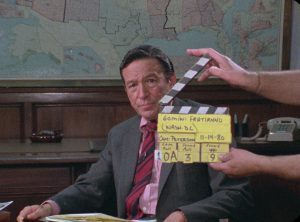
On the set of a 60 Minutes segment, journalist Mike Wallace prepares for one of many interviews he conducted during his 38 years with the show, a legacy examined in detail in the new documentary “Mike Wallace Is Here.” Photo courtesy of Magnolia Pictures.
In fact, Wallace was so intent on getting the word out that he even crossed swords with his own employer on occasion. This was perhaps most apparent with a 60 Minutes story about tobacco industry whistleblower Jeffrey Wigand, a Brown & Williamson biochemist who exposed the company’s tampering with its cigarette blends by adding chemicals to make them more addictive. When lawyers for CBS News advised pulling the original segment in favor of an edited version, citing breach of confidentiality concerns that could lead to a multibillion-dollar lawsuit against the network, Wallace fought to air the unedited story intact. The original version would eventually be broadcast, but not until after considerable criticism was leveled against the news magazine for caving in to corporate pressure. (Wigand’s story, told in the feature film “The Insider” (1999), portrays Wallace as complicit with the attorneys’ recommendations, but this documentary contends otherwise.)
Wallace’s commitment to his craft was undeniable, so much so that he was willing to try the untried. By pushing through limitations and so-called unbreachable barriers, he took interviewing and investigative journalism in entirely new directions. Many of his innovative approaches not only moved forward the progress of 60 Minutes, but they also helped influence the many news magazine progeny that followed. His willingness to ask the tough questions, the kind that more timid reporters were afraid to broach, distinguished him and his eagerness to get to the truth. Indeed, it came to characterize his value fulfillment, the conscious creation principle associated with being our best, truest selves for the betterment of ourselves and those around us. And, on this point, he succeeded brilliantly.
This in-depth look at the life and career of one of television journalism’s most influential reporters reveals how he significantly helped to reshape an industry and its practices. Through interviews before his death in 2012, as well as a wealth of archive footage, viewers witness the seasoned reporter at work in his many diverse conversations. The film also features interviews of Wallace conducted by colleagues Morley Safer, Barbara Walters and his son Chris Wallace in which he guardedly reveals his personal side, including a secret he never discussed with anyone. The overall package paints a picture of someone who opened up the profession to new tactics and styles of questioning, as well as to scrutiny about how far is going too far, an engaging documentary about a fascinating individual. Earlier this year, director Avi Belkin’s offering earned a Grand Jury Prize nomination in the documentary category at the Sundance Film Festival.
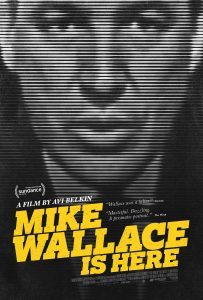
When we find our calling, it should be a cause for celebration – and a sign that it’s time to get to work on fulfilling our destiny. It may take us a while to reach that point, but we should look to ourselves and our beliefs to search for clues in uncovering what that entails. If we commit to that, as Mike Wallace did, there’s no telling what we can accomplish. And that’s certainly news worth sharing.
Copyright © 2019, by Brent Marchant. All rights reserved.
The post ‘Mike Wallace Is Here’ charts the quest for one’s calling appeared first on Brent Marchant.
August 10, 2019
This Week in Movies with Meaning
Reviews of “The Art of Self-Defense” and “David Crosby: Remember My Name,” as well as an epic film re-release preview, are all in the latest Movies with Meaning post on the web site of The Good Media Network, available by clicking here.
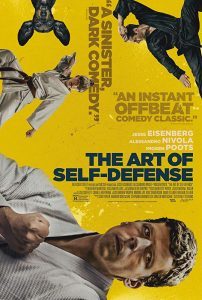
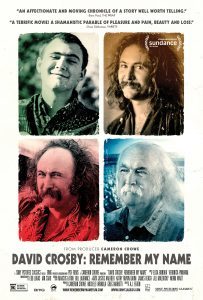


The post This Week in Movies with Meaning appeared first on Brent Marchant.
August 9, 2019
‘David Crosby’ celebrates an icon’s quest for creativity, redemption
“David Crosby: Remember My Name” (2019). Cast: Interviews: David Crosby, Jan Crosby, Roger McGuinn, Cameron Crowe, Henry Diltz. Archives: Graham Nash, Stephen Stills, Neil Young, Jackson Browne, Glenn Frey, Bob Dylan, Paul McCartney, John Lennon, George Harrison, Ringo Starr, Cass Elliott, Joni Mitchell, Christine Hinton, Jimi Hendrix, Dick Cavett, Jerry Garcia, Don Everly, Phil Everly. Director: A.J. Eaton. Web site. Trailer.
It’s amazing how someone can embody both the best and worst of what we’re capable of. These qualities, polar opposites to be sure, seem incompatible with one another, yet, on occasion, they sometimes wind up residing within a single individual. Learning how to reconcile these extremes can thus prove to be quite a challenge for those of us who want to do our best but find that there are times when it’s difficult to control ourselves. Such is the experience of a legendary musician as seen in the enthralling new documentary, “David Crosby: Remember My Name.”
Singer-songwriter David Crosby has led quite a storied life. Over his decades-long career, he’s been both a golden boy and a bad boy of the music business. And now, after years of living large, partying hard and burning more than his share of bridges, he’s come into the home stretch of his life with many accolades and numerous regrets.
So how does one deal with such a curious mixture of high praise and heavy baggage? That’s what the 76-year-old musician is attempting to do these days. There’s a sense of quiet urgency associated with this, too, given Crosby’s failing health. Having experienced several heart attacks, the implantation of eight cardiac stents, a liver transplant and the onset of diabetes, he realizes he could depart this world at any time. Which is why he’s trying to make sense of his life (and himself) with what time he has left.
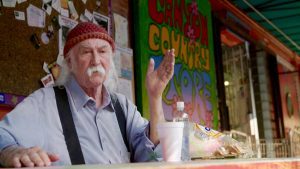
Legendary singer-songwriter David Crosby pays a visit to Laurel Canyon, his old stomping grounds and home to many up-and-coming musicians during the 1960s, as seen in the revelatory new documentary, “David Crosby: Remember My Name.” Photo by Edd Lukas and Ian Coad, courtesy of Sony Pictures Classics.
“David Crosby: Remember My Name” is more than just a nostalgic stroll down memory lane. To be sure, the film does cover the many diverse aspects of his career, including his often-stormy stint with the 1960s rock band the Byrds, his phenomenally successful collaborations with Stephen Stills, Graham Nash and Neil Young, and his legendary appearance at the Woodstock Music Festival. It also explores his professional and personal relationships with other high-profile musicians of the ʼ60s and ʼ70s, such as Jerry Garcia, Bob Dylan, Joni Mitchell, Cass Elliott and Jimi Hendrix. And it looks at his many romances, including those with Mitchell, with longtime girlfriend Christine Hinton (who was tragically killed in a traffic accident) and with his current wife, Jan.
But, despite his many successes, Crosby has also had his share of downfalls. In addition to his health problems and his long-lasting despair over Christine’s death, he has undergone serious bouts of addiction and prison time. He got himself fired from the Byrds for his unpredictable, unreliable and irresponsible antics, a number of them occurring while on stage and involving highly inflammatory political messages at the height of the social turbulence of the 1960s. And then there were his very public disputes with former collaborators like Byrds founder Roger McGuinn and all of his CSNY bandmates.
But, then again, Crosby has achieved accomplishments few others have attained. He’s been inducted into the Rock ʼn Roll Hall of Fame twice, first as a member of the Byrds in 1991 and then as a member of Crosby, Stills and Nash in 1997. And then, at age 72, when many of us begin kicking back and settling down, he launched head first into a prolific creative resurgence, producing four solo albums over four years, with more apparently to come.

Guitarist David Crosby rocks out during a concert featuring Crosby, Stills, Nash and Young (CSNY) as seen in director A.J. Eaton’s new documentary, “David Crosby: Remember My Name.” Photo by Neal Preston, courtesy of Sony Pictures Classics.
To many of us, such extreme contrasts probably seem incongruous. By Crosby’s own admission, they even seem that way to him. He’s not even sure how he’s managed to live as long as he has, given the passings of so many of his contemporaries, including some who lived less recklessly than he has. However, he’s made every attempt to be honest with himself about his behavior, acknowledging his shortcomings and realizing that his failings are of his own making and no one else. While he hopes that reconciliations with his former collaborators might be possible – an accomplishment he’s been able to achieve with most of his family members – he’s also cognizant enough to realize that such reunions are unlikely and that he’s the cause for that. In light of that, he accepts his feelings and responsibilities, hoping for redemption but nevertheless moving on, continuing to concentrate on what he does best – making music.
For better or worse, creative expression is something that often requires acquiring a range of experiences, both positive and negative. Were it not for that, artists might well not be able to produce their best work. While that certainly involves the heights of elation, it may also call for firsthand knowledge of painful despair, something most of us would rather eschew but that may be unavoidably integral to the successful unleashing of our inner muse.
That may help to account for Crosby’s experience. For what it’s worth, having gone through such ups and downs could help to explain his creative success, experiences made possible by the conscious creation process, the philosophy that maintains we manifest the reality we experience through the power of our thoughts, beliefs and intents. Although he lived through the free-thinking times of the 1960s counterculture, an era in which such alternative notions emerged from obscurity and gained a firm foothold in the culture, it’s unclear whether he became aware of or availed himself of this philosophical outlook. But, even if not, much of his life experience reflects many of the principles underlying this metaphysical mindset.

Musician David Crosby (center) performs with longtime collaborators Stephen Stills (left) and Graham Nash (right) in the new documentary, “David Crosby: Remember My Name.” Photo by Henry Diltz, courtesy of Sony Pictures Classics.
When looking at Crosby’s creative output in conjunction with the events of his life, one can see parallels between his personal experience and his artistic expressions. The “inspiration” provided by such incidents helped make that possible, both positively and negatively and in both his individual and collaborative efforts. Would that have happened if he had not drawn those experiences into his existence? That’s hard to say with certainty, but we have seen it with an array of other artists (including in a number of recent films) involving everyone from painters to musicians to actors. By having something to draw upon, these creatives have tapped into source material that helped them manifest their works, developments that might not have otherwise happened.
That’s important, too, for it’s crucial to one’s value fulfillment, the conscious creation principle that maintains we should strive to become our best, truest selves for the betterment of ourselves and those around us. Music has been Crosby’s destiny ever since he learned to sing and play the guitar, and, fortunately for him (and us), he was perceptive enough to recognize this ability and to make the most of it. His inventive melodies, blissful harmonies and thoughtful lyrics have given us much to savor, creations that have truly made the world a better place for him having been a part of it. One need only look, for example, at his involvement with the stirring protest song “Ohio,” a composition written by CSNY collaborator Neil Young in response to the 1970 Kent State University shootings, to see the impact his contributions have made on the national culture and psyche. His art helped unite us at a time when we needed it, leaving a legacy that has lasted ever since.
With that kind of impact, it’s easy to see how one’s influence on the culture can extend far and wide. The often-outspoken Crosby, for instance, helped shape the social and cultural landscape of the 1960s. He even unwittingly left an imprint on the art and politics of the time, as seen in a post-Woodstock appearance on The Dick Cavett Show in which he made his views as plain as day, helping bring radical new ideas to the mainstream. He even had impact on fashion and style, as evidenced by the looks, mannerisms and attitudes exhibited by the character played by Dennis Hopper in the radical cinematic epic “Easy Rider” (1969). When one can wield that kind of wide-ranging influence, it’s possible to reshape the world, even in matters of critical importance and individual style.

On stage at the peak of their career (from left) Neil Young, Graham Nash, David Crosby and Stephen Stills (CSNY) appear before a packed stadium audience as seen in the candid new documentary, “David Crosby: Remember My Name.” Photo by Joel Bernstein, courtesy of Sony Pictures Classics.
Crosby didn’t remain static throughout all this, either. He constantly evolved and changed, an expression of the conscious creation concept that we’re all in a constant state of becoming. This is reflected in his diverse musical repertoire, as well as his other artistic ventures, including occasional forays into acting and “modeling” for rock photographer Henry Diltz. It’s also apparent in the various roles he’s played in his vocation, having been everything from a peer collaborator to a solo act to a mentor for a new generation of musicians. That’s quite a range for multiple lifetimes, let alone one.
Given where Crosby is now, however, he’s most focused on certain goals, using his creative powers to fulfill as many of them as he can with the time he has left. Most of them center on the concept of redemption, both personally and artistically. It’s commendable that he recognizes this, too, for it’s a healthy approach to try to rectify our missteps. All too often we feel reconciled to our failures, convinced we’ll never be able to redeem ourselves. But, as the saying goes, nobody’s perfect, and we all make mistakes in the course of our individual journeys.
Oftentimes these missteps involve valuable life lessons that don’t always go perfectly on our initial attempts. But we don’t get only one attempt; we can always start anew if we allow ourselves to do so. Conscious creation makes it possible to try again, invoking different beliefs and trying different approaches, new and improved initiatives that, one can hope, will work. That certainly seems to be what Crosby is doing now. Let’s wish him the best.
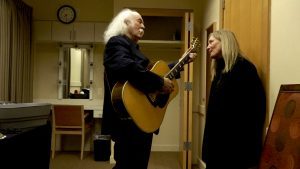
With wife Jan (right), guitarist David Crosby (left) shares a private moment in the new documentary, “David Crosby: Remember My Name.” Photo by Edd Lukas and Ian Coad , courtesy of Sony Pictures Classics.
Hands down, this is one of the best music/celebrity biographical documentaries I have ever seen. In many ways it’s a personal confession, providing an unflinchingly candid look at someone who wants to bare his soul, make reparations for whatever he can and leave the world with as much of his gift as he’s able to create. Through uncensored interviews with the artist and those who know him, as well as a wealth of archive photos and footage, viewers are treated to an honest, introspective look at one of the most influential musicians of the ʼ60s and ʼ70s. Director A.J. Eaton and executive producer Cameron Crowe have put together one helluva picture here, a Grand Jury Prize nominee in the documentary category at the Sundance Film Festival. Don’t miss this one.
Time passes us by quickly with no regard for how we feel about that. As a consequence, it’s up to each of us to manage this resource as best we can, making the most of it and certainly not squandering it. But, should we screw up, all is not lost; we always have a chance to make up for our errors, even when the clock is running out. The key, though, is taking charge of our efforts and invoking beliefs that will bring about what we hope to achieve while we have time left. David Crosby provides us with an excellent example of how to go about this, showing that it’s never too late to make amends – or a little music.

Copyright © 2019, by Brent Marchant. All rights reserved.
The post ‘David Crosby’ celebrates an icon’s quest for creativity, redemption appeared first on Brent Marchant.
August 6, 2019
‘The Art of Self-Defense’ warns about the perils of fanaticism
“The Art of Self-Defense” (2019). Cast: Jesse Eisenberg, Alessandro Nivola, Imogen Poots, Steve Terada, Phillip Andre Botello, David Zellner, Hauke Bahr, Davey Johnson, Nicholas Hulstine, Scott Goodman, Justin Eaton. Director: Riley Stearns. Screenplay: Riley Stearns. Web site. Trailer.
Crossing the line from passion to obsession is a dangerous step. One need only look at the many high-profile examples found in our world these days. But this phenomenon is by no means limited to the events we see on the nightly news; it can crop up anywhere, even in seemingly innocuous places, a troubling subject explored in the edgy new dark comedy, “The Art of Self-Defense.”
Thirty-something office worker Casey Davies (Jesse Eisenberg) could seriously stand to grow a pair. The easily bullied milquetoast cowers in fear about nearly everything, but, considering how often and how readily he’s picked on – by virtually everyone he encounters, from co-workers to coffee house patrons to strangers in parking lots – his reaction is understandable. And what’s worse is that he keeps taking it. But that all changes one night; while walking home after running out to buy dog food for his pet dachshund, he’s mugged by a renegade motorcycle gang, leaving him seriously injured.
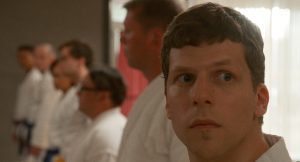
Frequently bullied office worker Casey Davies (Jesse Eisenberg, foreground) decides to learn how to protect himself by enrolling in karate school, a move that gets him more than he bargained for, as seen in the new dark comedy, “The Art of Self-Defense.” Photo courtesy of Bleecker Street.
While recuperating, Casey decides he needs to do something to protect himself. He opts to buy a handgun, but, as he fills out the background check paperwork, he begins having reservations. He leaves the store ambivalent about the idea and goes for a walk, stumbling upon a karate studio. He enters and watches a class in session – and is instantly captivated.
When class is over, Casey approaches the dojo’s ultra-cool Sensei (Alessandro Nivola), expressing a keen interest in learning the ancient art. He professes that he wants to become one of the people who routinely taunt him, a revelation that prompts the Sensei to assertively court the wannabe student. Casey eagerly agrees to enroll, but with no idea of what he’s about to get himself into.
To say more would reveal too much, but suffice it to say that Casey is steadily overwhelmed by his circumstances. While he appears to have quite a knack for karate – a proficiency that empowers the new student and impresses the Sensei – he soon finds himself embroiled in a dark and sinister situation. The uber-masculine, quasi-misogynistic, testosterone-dripping Sensei carries his attitude, practices and instruction more than a little too far, leading the gullible, impressionable Casey down some very questionable paths involving his personal behavior, his professional life and his home life. A macabre and tangled web of deception gradually emerges involving an off-limits equipment room, a female brown belt instructor regularly passed over for advancement to black belt (Imogen Poots) and the aforementioned motorcycle gang. And, as the story unfolds, Casey has a lot more to worry about than just protecting himself from being bullied.

The enigmatic Sensei (Alessandro Nivola) of a karate studio practices more than a few unconventional tactics in the offbeat new dark comedy, “The Art of Self-Defense.” Photo courtesy of Bleecker Street.
Most of us would agree that there’s nothing wrong with being passionate about something, be it a hobby, a sport or some other innocent endeavor. But, when we carry things too far, when we venture into the realm of fanaticism, we could face a number of problems, some potentially serious. That can be compounded, too, if we drag others along with us, spreading the possibility of pain and anguish to unwitting accomplices.
But how do such matters get out of hand? In essence, it comes down to how we view these undertakings and what we come to believe about them. There can be a fine distinction between diversion and obsession. But, in both cases, they’re fueled by the power of the beliefs that underlie them. And that is what ultimately makes things materialize as they do, a consequence of the conscious creation process, the philosophy that maintains we manifest the reality we experience through the power of our thoughts, beliefs and intents.
In a situation like the one portrayed here, one might wonder how a fervent but benign interest in martial arts can transform into something much more menacing. To understand this, we need to look not only at the beliefs driving the interest in karate, but also any associated beliefs related to it – its defining characteristics, its intended purpose, how and why we put it to use, and so forth, the particular traits that come to distinguish how each of us practices the sport and for what reasons. On the surface, it all may just look like karate, but, upon closer examination, we might see one person practicing a competitive activity while someone else is engaged in something clandestine with a frightening agenda. And, when scenarios like the latter one take root, we run the risk of fanaticism taking over.
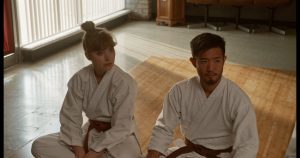
Brown belt karate instructor Anna (Imogen Poots, left) regularly gets passed over for elevation to black belt status, a source of frustration for the accomplished practitioner, as seen in the absurdist dark comedy, “The Art of Self-Defense.” Photo courtesy of Bleecker Street.
As this story plays out, viewers witness the Sensei’s true nature emerge. It becomes apparent that he’s not teaching a noble martial art but, rather, preaching a gospel of intimidating hyper-masculinity, modestly tinged with veiled homoeroticism and an undeniable hostility toward weakness or anything feminine. These ancillary aspects of his own particular brand of instruction are far from the traditional teachings of the ancient masters, yet there they are, firmly rooted in his class sessions, fanatical lessons that he seeks to pass along to his students.
This naturally begs the question, “Why?” In the conscious creation treatise The Individual and the Nature of Mass Events, author Jane Roberts explains that fanaticism often arises from experiences in which an individual believes in a need to make a point while simultaneously attempting to make up for personal failings, frequently by overcompensating in the process. When applying that principle to the Sensei’s efforts at extolling his macho, chauvinistic dogma, it’s not too hard to figure out where the “inspiration” for his current actions may have come from. And the fact that his teachings focus more on punishing one’s enemies rather than practicing self-defense speaks volumes. Whatever experiences he may have had that prompted these beliefs, they were obviously significant enough to establish intents that have become firmly entrenched and are now freely materializing, questionable though they may be.
Given Casey’s personal experiences, it’s not too difficult to imagine how he might be intrigued by the Sensei’s charisma. In many ways, the Sensei is who Casey wants to be – at least initially. However, when he begins to see the Sensei for who he really is, he realizes that he may be dealing with yet another bully, especially as the nefarious nature of his schemes is revealed. How Casey responds to this scenario is his new challenge, and that response will depend on his beliefs. Can he succeed at becoming who he claims he wants to be?
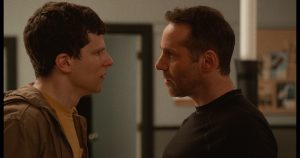
As the relationship between karate student Casey Davies (Jesse Eisenberg, left) and his Sensei (Alessandro Nivola, right) becomes strained, the tension between them grows significantly as seen in “The Art of Self-Defense.” Photo courtesy of Bleecker Street.
Interestingly, while the film focuses on the relationship of the two principals, in many regards the story is a microcosmic metaphor for the wider world. Given the current sociopolitical situation of the nation (some might say the entire world), many of us are being intimidated, or even attacked, by a plethora of bullies. Those doling out the threats and injuries are not unlike the Sensei, a chilling symbol representative of the individuals and institutions who are trying to put us under their thumbs. Will we succumb to the pressure? Or do we believe in ourselves enough to rise to the occasion, even if it means having to take on those who falsely claim they want to help us? That’s a tall order, for sure, but, as Casey discovers for himself, that may be just what we need to do, too. Ironically, he may end up being an unlikely role model not only for himself, but also for the rest of us.
Of course, everything depends on whether we believe we can accomplish our aspirations. That goes for Casey, as well as the rest of us. If we look deeply enough, though, there’s a good chance we’ll find the inner strength and fortitude needed to realize those goals – provided we give them a chance to reveal themselves. Along the way, though, we must also heed the message of this cautionary tale and keep ourselves from employing the same kinds of tactics in taking on the fanaticism that confronts us.
This rivetingly funny but edgy dark comedy, reminiscent of “Fight Club” (1999), is certain to make viewers both laugh – and squirm – in their seats. Eisenberg and Nivola are perfect foils for one another, each turning in fine performances in which they serve up ample helpings of neuroticism and creepiness in their respective roles, an intriguing combination that never disappoints. The picture’s extensive use of deadpan humor evokes frequent unexpected laughs, getting plenty of mileage out of intrinsically absurd situations and not having to rely on one-liners alone. The film admittedly has a few plot holes and requires leaps in believability along the way, but they also add to the somewhat surreal quality of this satire, which doubles as both an intriguing story of its own and a less-than-veiled social-political commentary. Director Riley Stearns’s second feature offering is definitely one of the funniest, strangest and most decidedly twisted offerings of the year.

No one likes bullies, but, in facing them down, we must be careful not to inadvertently become who we oppose. This calls upon us to take a good, hard look at the beliefs – all of them – that play a role in a venture like this. We don’t want to fall prey to that which we detest. That calls for us to get creative in our approaches to addressing these matters, using whatever we have at our disposal, including in unheard-of ways, forms of self-defense that truly are an art.
Copyright © 2019, by Brent Marchant. All rights reserved.
The post ‘The Art of Self-Defense’ warns about the perils of fanaticism appeared first on Brent Marchant.
This Week in Movies with Meaning
Reviews of “The Farewell,” “Becoming Astrid” and “This Changes Everything,” as well as a fitting farewell tribute, are all in the latest Movies with Meaning post on the web site of The Good Media Network, available by clicking here.
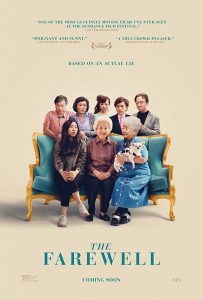
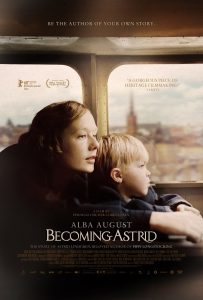
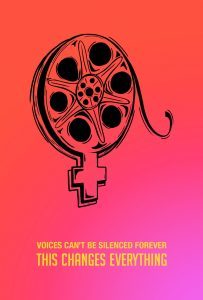


The post This Week in Movies with Meaning appeared first on Brent Marchant.
August 5, 2019
Tune in for The Cinema Scribe
Tune in for the latest Cinema Scribe segment on Bring Me 2 Life Radio, Tuesday, August 6, at 2 pm ET, available by clicking here. And, if you don’t hear it live, catch it later on demand!


The post Tune in for The Cinema Scribe appeared first on Brent Marchant.
August 4, 2019
‘The Farewell’ explores how to arrive at the best outcome
“The Farewell” (2019). Cast: Awkwafina, Shuzhen Zhou, Diana Lin, Tzi Ma, Han Chen, Aoi Mizuhara, Yongbo Jiang, Lu Hong. Director: Lulu Wang. Screenplay: Lulu Wang. Web site. Trailer.
When it comes to caring for the well-being of others, is total honesty necessarily the best policy? Isn’t it possible that there could be something to be said for “blissful ignorance?” But then isn’t it unconscionable to intentionally leave someone in the dark? These are thorny questions, much of which depends on one’s perspective, both individually and as part of a collective, issues that are among those addressed in the touching new comedy-drama, “The Farewell.”
Grad student Billi Wang (Awkwafina) leads a full life In New York. While anxiously awaiting word on a fellowship application, the Chinese-born émigré and would-be writer spends much of her time trying to figure out how to make ends meet, a challenging task to be sure. And, when not looking for ways to keep her head above water financially, she visits with friends and her parents, Jian, her mother (Diana Lin), and Haiyan, her father (Tzi Ma), who brought the family to America more than 20 years ago when he landed a translator’s job.
As much as Billi tries to stay upbeat, however, she’s pressed to remain positive when she learns she’s been turned down for the fellowship. And, if that weren’t enough, she receives more bad news when she visits her parents. Word has come from China that the family matriarch, Billi’s grandmother, Nai Nai (Shuzhen Zhou), has been diagnosed with Stage 4 lung cancer. Needless to say, Billi is devastated by the news. She adores her grandmother, particularly for the words of love and encouragement she routinely doles out during their frequent phone conversations.
But Billi is even more upset by some additional disturbing news: She learns from her parents that the extended family has no plans to inform Nai Nai about the severity of her condition. It’s a practice commonly employed by relatives with terminally ill patients in China, a belief based on the notion that there’s no point in unduly burdening the dying, particularly those in otherwise-good spirits. The thinking goes, “Why spoil their mood, especially if they have little time left?”

The family thus intends to keep Nai Nai in the dark, a plan that Billi has major problems with. Having spent most of her life in the U.S., she’s accustomed to Western ways, including full disclosure under such circumstances. Her protests are dismissed, though, her parents insisting that she’s not say a word to Nai Nai. They explain to her that their plan is the Eastern way, one that Nai Nai herself used when she learned that her husband was dying years earlier. Billi’s told that she’s expected to comply, given that all of the other members of the extended family have agreed to go along with it.
Billi also learns that the plan will get put to the test at an upcoming family gathering. Billi’s cousin, Hao Hao (Han Chen), who lives with his family in Japan, recently announced his engagement to his fiancée, Aiko (Aoi Mizuhara). They decided to marry in China, using the occasion as a front for a reunion that will likely double as a veiled farewell to Nai Nai. Everyone will be in on the secret except, of course, the guest of honor, who has been carefully conditioned to suspect nothing, leading her to believe that she’s in perfect health, that all of her recent medical test results came back as benign.
Unsure how she’ll hold up under this pretense, Billi has reservations about the cover story – and whether she’ll be able to go along with it. It’s something the family has anticipated, too. No sooner does Billi express her concerns when Jian and Haiyan tell her that they don’t want her to attend the reunion, fearful that she’ll crack under the pressure and let something slip. Given her love for Nai Nai, though, she disregards the request and makes the trip, albeit with great trepidation.
When Billi arrives in the family home of Changchun, everyone is astounded to see her. Haiyan, Jian, Hao Hao and Aiko, along with Billi’s uncle, Haibin (Yongbo Jiang), and grandma’s younger sister, Little Nai Nai (Lu Hong), are shocked when the unexpected guest arrives. They’re all worried enough that they will not be able to keep up a good front, but now they have concern that their Americanized relative will be able to keep mum, too.
The one most perplexed by this, of course, is Nai Nai herself. Unaware that anything is going on, she’s her usual cheerful self. She’s pleased that the whole family is together again, something that hasn’t happened for a long time. And she eagerly goes about planning the wedding reception, paying close attention to every last little detail. But, at the same time, she senses something may be amiss – the long faces and melancholy moods of her relatives suggest something is wrong, even if she can’t identify specifically what.
As this scenario plays out, the family experiences a number of close calls. Little Nai Nai and brothers Haiyan and Haibin do their best to run interference, but tricky situations arise often, placing the entire plan on the verge of falling apart. And, ironically enough, Billi is seldom the cause for concern in these instances. With the wedding approaching, the family’s subsequent departure pending and Nai Nai’s health showing signs of further deterioration, it remains to be seen whether everyone will be able to successfully hold things together. The desire to say a cloaked but heartfelt farewell comes into conflict with the need to say a proper goodbye, a challenge made more difficult by emotions that are continually being amped up.
Those of us accustomed to Western ways will likely side with Billi when it comes to her view of full disclosure. The sense of staring down the truth, no matter how difficult, is undoubtedly an outgrowth of the concept of rugged individualism, a trait especially ingrained in the American psyche. The idea of tackling challenges – even those likely doomed to futile failure – permeates our “take it like a man” culture, regardless of gender.
In the East, however, it’s often a different story. Despite living in the Westernized cultures of America and Japan, much of Billi’s family still clings to the old traditions, especially those that involve collective efforts. Indeed, as Billi’s Uncle Haibin observes, in the ways of the Old World, one’s life is not necessarily one’s own, that individuals are part of a collective in which everyone is expected to participate and cooperate for the well-being of the whole, even if such efforts go against one’s personal views and particularly if they contribute to the betterment of society or the well-being of others (especially family members).
So which view is right? That’s difficult to say, since both are fundamentally governed by beliefs, the building blocks of the conscious creation process, the philosophy that maintains we draw upon these tools to manifest the reality we experience. And, since conscious creation makes essentially anything possible, there’s no single answer that is intrinsically right or wrong. For those of us in the West, the individualistic perspective is most likely preferred, while Easterners may invariably opt for the collective view, regardless of what issue is up for consideration. Neither is inherently right nor wrong; they’re just different, and each is made equally possible by the manifestation process.
No doubt adherents to each view will argue in favor of his or her perspective, and each would likely make good cases for the beliefs that underlie their outlooks. A Western individualist, for instance, might say that disclosure would provide a terminally ill patient with the knowledge to decide how he or she wants to spend whatever time is left, be it for getting affairs in order, saying what needs to be said to loved ones or even fulfilling items on a bucket list. At the same time, someone with an Eastern perspective who believes in sparing someone’s feelings might contend that such knowledge could be unduly deflating, plunging a dying individual prematurely into the depths of despair and ruining whatever time is left, perhaps even derailing any efforts aimed at fulfilling the foregoing goals.
By contrast, those who believe in shielding the infirmed might argue that this practice can help preserve the attitudes of those with a positive mood, a particularly valuable asset for those looking to make the most of their lives, regardless of whether or not they’re aware of how much time they have left. Indeed, some might say, “Why upset Grandma if she’s enjoying herself? Maybe her happiness will prolong her time with us.” However, the devil’s advocates out there could say this is akin to a cruel, patronizing joke, one in which condescension is the impetus behind such efforts. Such opponents might claim that this is essentially saying “There, there, don’t worry, you’re going to live forever anyway.”
As these examples illustrate, there are good arguments – and reservations – on both sides, and each have their own particular validity. We should remember, though, that the affected individual has his or her own say in the matter as well; after all, we each create our own reality, and our own belief input will ultimately be most determinative. We will be the ones who determine our outcomes, so our own beliefs will carry the greatest weight. One need only look to Nai Nai’s belief in her perfect health to see how it not only affects her attitude, but also her physical constitution. For someone with Stage 4 lung cancer, she certainly seems remarkably vital, a result that undoubtedly arises from her resolute belief in that notion.
However, this is not to suggest that “outside” input won’t factor into matters. The impressions they leave on us will invariably help to shape our beliefs. So, if we hope to impact the intents of others, we had better make sure we’re sincere in our efforts, for others may well sense its absence. This becomes apparent, for instance, when Nai Nai questions the long faces and somber attitudes of her family members at what should be a happy occasion. If the integrity required to make this believability work is absent, all bets could be off.
This scenario also provides an intriguing look at co-creation, where our collective efforts combine to bring about a particular result, no matter what contributions we each make toward realizing the eventual outcome. There’s naturally the group effort put forth by the extended family, all of whom are working toward what they believe are Nai Nai’s best interests. And then there’s the matriarch’s own individual endeavors, most of which would fundamentally seem to mirror the intents of her relatives, even if driven by a different set of manifesting beliefs. In sum, though, they’re all working toward Nai Nai enjoying a happy and fulfilling life, no matter how much time she may have, and, in the end, that’s what really counts. With that at work, we may even surprise ourselves at just how much success we can achieve.
Director Lulu Wang’s excellent comedy-drama about how to handle an impending family tragedy is one of the most capably made, thoroughly satisfying films of this or any other year. With excellent performances by Awkwafina and Shenzhen Zhou and a superb, smartly written script, the picture takes viewers on an emotional rollercoaster, from laughter to tears to heartfelt warmth and back again. There’s so much to like here that it’s difficult to get one’s hands around everything it has to offer. Let’s hope this one is remembered come awards season.
Billed as being “based on an actual lie,” “The Farewell” presents a thoughtful look at difficult and touchy questions, many of whose answers might not be as definitive or clear-cut as many of us would like to believe. It gives us much to ponder, not only for circumstances like this, but also in realizing that there may be multiple approaches available for addressing any kind of difficult situation. By taking a reasoned, open-minded approach to such scenarios, we may find we have a variety of options open to us to arrive at the best, most satisfying outcomes, and who could argue with that?
Copyright © 2019, by Brent Marchant. All rights reserved.
The post ‘The Farewell’ explores how to arrive at the best outcome appeared first on Brent Marchant.
July 29, 2019
‘This Changes Everything’ examines remedies for a glaring disparity
“This Changes Everything” (2018 production, 2019 release). Cast: Marisa Tomei, Jessica Chastain, Reese Witherspoon, Natalie Portman, Chloë Grace Moretz, Meryl Streep, Zoe Saldana, Cate Blanchett, Gillian Anderson, Rashida Jones, Sharon Stone, Amandla Stenberg, Heather Graham, Rosario Dawson, Geena Davis, Mary-Louise Parker, Sandra Oh, Tiffany Haddish, Taraji P. Henson, Rose McGowan, Brit Marling, Ellen Pompeo, Amber Tamblyn, Yara Shahidi, Jackie Cruz, Lena Dunham, Marg Helgenberger, Tracee Ellis Ross, Judd Apatow, Alan Alda, Paul Feig, Shonda Rhimes, Jill Soloway, Patty Jenkins, Catherine Hardwicke, Mira Nair, Kimberly Peirce, Lesli Linka Glatter, Julie Dash, Lynne Littman, Maria Giese, Cherien Dabis, Courtney Kemp Agboh, Callie Khouri, Anita Hill, Kalpana Kotagal, Melissa Goodman, Maureen Ryan, Howard Rodman, Clifford Alexander. Director: Tom Donahue. Web site. Trailer.
Movies and TV shows are wonderful outlets for entertainment, information and enlightenment. They provide us with tremendous sources of inspiration and creativity, especially for younger impressionable viewers. But are they everything they truly can be? Are they serving the wants and needs of all the audiences out there? What’s more, are they making available opportunities for creative expression to everyone in the business? If one were to ask many women in the entertainment industry, their answers would likely be characterized by dissatisfaction, disillusionment and frustration. And, to learn where those feelings come from, one need only look to the practices and outlooks of the decision-makers in the business, revelations made loud and clear in the eye-opening new documentary, “This Changes Everything.”
The movie and television industries are replete with many talented women, both in front of and behind the camera. But are they all getting a fair shake when it comes to work opportunities? Moreover, when it specifically comes to on-screen appearances, are those that are available giving women enough chances to show what people of their gender can do?
As many prominent women in the business contend, the foregoing are important questions, because their answers have ramifications that extend far beyond their professional accomplishments. “This Changes Everything” takes a critical look at these issues, examining and statistically documenting the disproportionate number of jobs open to women in behind-the-scenes careers, such as directors, producers, showrunners and technical positions. Likewise, the picture does the same when it comes to comparing the number of available roles and the amount of allotted screen time for women compared to their male counterparts. It also shines a bright light on the limited range of roles in which women are typically cast, most of which are restricted to parts as girlfriends, sidekicks and victims in need of being rescued.

Actress-producer Geena Davis discusses the disparity in opportunities for women in the film and television industries in the eye-opening new documentary, “This Changes everything.” Photo courtesy of Fathom Events.
Those in the industry who are concerned about the foregoing worry about the repercussions associated these issues, not just for those in the business, but also in society at large. Why? Because of the messages these practices send to viewing audiences, especially children. For instance, if young girls are only exposed to images of women who fall into the limited range of roles noted above, what does that tell them about who they are and what they can become in life? Those who might aspire to careers, callings or lifestyles different from the three options previously discussed may never discover that other possibilities exist simply because they don’t see any female role models depicted in those capacities or scenarios. And, given that our contemporary entertainment vehicles strongly define the nature of our culture, they carry tremendous impact on who we are, how we see ourselves and what we believe we’re capable of, particularly during our formative years.
To that end, the subjects interviewed for this film – including representatives of both genders – contend that women need more opportunities in the business to get their voices heard and their viewpoints expressed, not only because they have something to say creatively, but also to help play a greater role in shaping society’s outlooks (and thus the roles in which young women can see themselves). Those are some rather staggering implications, notions that are typically overlooked, either unconsciously or intentionally.
It’s somewhat ironic that these circumstances exist compared to the early days of Hollywood, when women were on a nearly equal footing with their male counterparts. During the Silent Era, women held many prominent roles as writers and directors, some of them wielding considerable influence and commanding lucrative contracts. However, by the time talkies began to be made in the late 1920s, things began to change. As Hollywood now had to build large, expensive sound stages, that called for hefty infusions of cash, a resource controlled by bankers, most of whom were men, and those finance men only wanted to deal with other men. That’s when the balance tipped to the male side, where it has stayed ever since.

Veteran performer Meryl Streep observes how changing our entertainment changes our culture in the new documentary, “This Changes Everything.” Photo courtesy of Fathom Events.
To be sure, there have been instances where women have stepped to the fore, achieving impressive accomplishments both as on-screen protagonists and behind the camera. However, progress has largely taken the form of fits and starts that have not been able to sustain themselves. Cinematic blockbusters like “Thelma & Louise” (1991), for example, made huge, temporary splashes, yet all the prognostications that such releases would change things from there on out failed to materialize.
So why have women been left out of the game? There are various reasons, such as an industry that operates on a “good old boys” mentality. Then there are largely ineffective professional policies, such as self-regulation to supposedly ensure equal opportunities, a largely toothless enforcement regime. Prejudices against women being unable to get the job done also run rampant, despite plenty of examples to the contrary, both on the big and small screens.
Perhaps the most insidious reason, though, is an unconscious bias against inclusion. When male decision-makers move forward with their projects, they automatically tend to think in terms of which men for which roles, both on- and off-screen. Because women receive no consideration, they don’t make the cut for these opportunities. And that is what leads to male-dominated entertainment vehicles, which brings us back to the aforementioned issue of exclusion in on-screen representation and the attendant lack of role models.
If all this weren’t enough, though, women also face more than their share of indignities at the hands of male colleagues. The sexual harassment allegations raised against industry bigwigs like Harvey Weinstein are well known, but these high-profile cases are just the tip of the iceberg. As one actress in the film notes, she had an experience during a shoot where a male professional suggested that she sit on his lap when going over the lines for a scene, a proposition to which she responded by asking, “Do you have Tom Hanks sit on your lap when running the lines with him?”

Actress Taraji P. Henson speaks about the opportunities available for women in general, and women of color in particular, in the revealing new documentary, “This Changes Everything.” Photo courtesy of Fathom Events.
The indignities go beyond that as well. All too often, men in the business seek to objectify their female counterparts, pressuring actresses to do things for their roles that are designed to fulfill their aspirations for what constitutes the ideal woman, one who is essentially defined by sexuality and nothing else. For instance, actress Chloë Grace Moretz recounts an incident from one of her early roles where she found padded bra inserts (crassly referred to as “chicken cutlets”) left in her dressing room to accentuate her bust line, a message intended to let her know that nature hadn’t endowed her sufficiently enough to fulfill the vision the filmmakers held for her. As a budding young actress, she added, one can imagine what this gesture did to her self-esteem.
All of the foregoing policies and practices have become so ingrained that they have turned into widely held beliefs, particularly among those who are gatekeepers and controllers of the purse strings. And those beliefs have subsequently fueled the manifestation of the reality that is Hollywood, a result not at all surprising in light of the power of the conscious creation process, the philosophy that maintains we materialize the existence we experience through these metaphysical building blocks.
However, despite the power of these driving forces, they are by no means fixed or unchangeable. There have been times over the years, for instance, when progress – though limited – has been made. Those instances show that change is indeed possible; the trick, however, is figuring out how to maintain it. And, with new tactics in the offing, women in the industry may well be on the verge of instituting practices that could alter the standard operating procedures, a change made possible by implementing new beliefs with different and sustainable outcomes.

Actress-producer-director Natalie Portman discusses the limited opportunities available for women behind the camera, noting that she herself is one of the few female directors she has ever worked with, as seen in “This Changes Everything.” Photo courtesy of Fathom Events.
For example, many in the business firmly believe in the notion that “numbers don’t lie.” To that end, actress Geena Davis established the Geena Davis Institute on Gender in Media to quantify the opportunities available to women in the movie and television industries, a project aimed at statistically showing just how limited they really are. The findings of those studies, presented liberally throughout this film, bear out what most women in Hollywood have instinctively known for a long time. These results thus provide a powerful argument to counter the contentions of men in the business who mistakenly believe that more opportunities for women exist than there really are. With such numbers in hand, women like Davis observe that men can’t disregard these figures if they’re to be taken seriously.
Numbers involving dollar signs tend to speak especially loudly, yet there’s been a long-held belief in Hollywood that only men can generate financial windfalls. The film dispels that idea, however, by presenting examples set by movies like “Wonder Woman” (2017), an action-adventure picture showcasing a female protagonist (Gal Gadot) and directed by a woman (Patty Jenkins), and the television shows created by Shonda Rhimes, executive producer of Grey’s Anatomy, Scandal and How to Get Away with Murder, all of which feature formidable women characters. These vehicles have been cash cows for their respective organizations, positively obliterating the conventional wisdom about what creative women are able to accomplish.
Davis’s organization also focuses specifically on fostering opportunities for creatives who seek to eliminate gender bias in entertainment vehicles aimed at children 11 and under. This is an effort that embodies the previously discussed notion that changing the programming that changes the message can change the culture. And that goal is attainable by changing who creates those entertainment vehicles in the first place.
According to the film, there’s evidence that backs this up, too, a phenomenon known as “the CSI effect.” Actress Marg Helgenberger, a cast member of the long-running television show CSI: Crime Scene Investigation, a series focused on forensic police investigation techniques, notes that, after appearing in more than 260 episodes, she had such an impact on young female viewers that the number of women who enrolled in this field of study swelled dramatically. Admittedly, this evidence is somewhat anecdotal, but its significance can’t be ignored.

Television star Yara Shahidi discusses the opportunities for women newcomers in the business in “This Changes Everything.” Photo courtesy of Fathom Events.
These initiatives, the product of inspired thinking and beliefs, are designed to help push past the barriers that have held women back. They show that limitations can indeed be overcome. Thanks to the notions espoused by efforts such as these, as well as those of other enterprises like the #MeToo movement, the tide at last seems to be turning. It may not be happening fast enough for some, but the momentum does seem to be carrying it forward, surpassing the stalling points that occurred with many efforts of the past. With the continued efforts of those behind these movements, sustained co-creative input from all of their participants and firmly rooted beliefs in what is truly possible, there’s no telling what might happen. This really could change everything.
This eye-opening look at the creative and managerial under-representation of women in the motion picture and television industries scathingly exposes a disparity in the business that’s been far more egregious than most of us were probably aware of. The film’s star-studded array of interviews with performers, directors, producers, showrunners, talent agents and others is truly impressive, as is its selection of clips from a wide range of movies and TV shows. The war stories from such veteran performers as Marisa Tomei, Jessica Chastain, Reese Witherspoon, Natalie Portman, Meryl Streep, Cate Blanchett, Gillian Anderson, Sharon Stone, Geena Davis, Mary-Louise Parker and Sandra Oh, as well as comparative newcomers like Tiffany Haddish, Taraji P. Henson, Yara Shahidi, Jackie Cruz and Chloë Grace Moretz, speak volumes, revealing a pattern of policies and practices sorely in need of reform. Except for an important (but decidedly overlong) segment about a decades-old lawsuit that was initiated to correct these issues among Hollywood directors, the picture is solid across the board, shining a bright light on one of the entertainment industry’s dirty little secrets – one whose societal and cultural implications extend beyond just what amuses us.

“This Changes Everything” may be a little difficult to find, at least in the near term. The picture has been playing at a number of film festivals and was the subject of a national one-night-only theatrical presentation by Fathom Events on July 22. However, the film will be available on DVD and video on demand in October. It’s truly worth the wait.
Holding back an inspired creative force is ultimately like trying to stop a tsunami. Sooner or later there will be a breakthrough, and, for women in the entertainment business, it would appear that such an inevitability is on the brink of happening. This is a welcome and refreshing change, one that can only make an impressive industry even more vital and vibrant. And, for move lovers like me, that can’t happen soon enough.
Copyright © 2019, by Brent Marchant. All rights reserved.
The post ‘This Changes Everything’ examines remedies for a glaring disparity appeared first on Brent Marchant.
July 23, 2019
‘Becoming Astrid’ explores how we become who we are
“Becoming Astrid” (“Unga Astrid”) (2018). Cast: Alba August, Trine Dyrholm, Henrik Rafaelsen, Magnus Krepper, Maria Bonnevie, Björn Gustafsson, Marius Damslev, Mira Mitchell, Maria Fahl Vikander, Maria Alm Norell, Willy Ramnek Petri. Director: Pernille Fischer Christensen. Screenplay: Kim Fupz Aakeson and Pernille Fischer Christensen. Web site. Trailer.
As we grow up, we lay the foundations for our lives and for who we end up becoming. Some of us may feel that this results from a series of happenstance events, random occurrences that seemingly materialize with no rhyme nor reason. Yet, if we look closely enough, there’s a certain order to things, with elements that unfold from identifiable aspects of our upbringing, many of which, in hindsight, often appear purposeful, as if they arise from defined, deliberate underlying influences and initiatives. Thus, when we examine our lives from that perspective, it’s quite possible to clearly see how we become who we are. Such is the case with the film chronicle of the formative years of a beloved children’s author, “Becoming Astrid” (“Unga Astrid”), available on DVD and video on demand.
Astrid Lindgren (née Ericsson) (Alba August) enjoyed living her life as a free-spirited adolescent in rural Sweden in the 1920s, despite a pervasively conservative upbringing. Her willingness to quietly but forthrightly question authority often ran afoul of the strict, religious-based rearing of her parents, most notably her mother, Hanna (Maria Bonnevie). However, even under such stern conditions, Astrid steadily began to assert herself, a quality recognized (and discreetly applauded) by her father, Samuel (Magnus Krepper), who wanted to see his daughter develop the life skills that would enable her to become self-sufficient and successful. So, when he learned about an internship opening at the local newspaper, given Astrid’s budding talent for writing, he encouraged her to pursue it.
When Astrid inquired about with position with the editor, Reinhold Blomberg (Henrik Rafaelsen), a strong rapport developed between them almost immediately. Blomberg was impressed with Astrid’s prose and her ability to efficiently organize the operations of the newspaper office. He was also smitten with her youthful beauty, something that helped take his mind off the contentious divorce he was going through with his wife, Olivia (Maria Alm Norell). Blomberg’s infatuation with his new intern soon led to an affair – and to Astrid’s unplanned pregnancy.
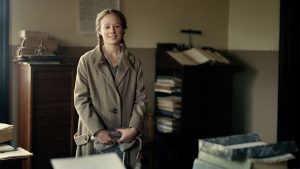
A teenage Astrid Lindgren (née Ericsson) (August Alba) launches what would become a successful writing career by working as an intern at a small town newspaper in rural Sweden in the engaging biopic, “Becoming Astrid” (“Unga Astrid”), available on DVD and video on demand. Photo courtesy of Music Box Films.
In light of the social values of the time, Astrid couldn’t stay in her hometown of Vimmerby. She relocated to Stockholm, where she enrolled in a secretarial training course and took a job to support herself while her pregnancy ran its course. When it was time to give birth, she traveled to Copenhagen, Denmark to have her baby in seclusion, a precaution designed to keep the unwed mother out of the public eye of her homeland. She soon became mother to a newborn boy, Lars, whom she called Lasse (Marius Damslev), leaving the infant in the care of a foster parent, Marie (Trine Dyrholm), until conditions were more conducive to bring her child back home to Sweden.
However, despite her efforts to manage these matters as delicately and pragmatically as possible, Astrid experienced some obstacles. Blomberg, who had promised to marry Astrid once his divorce was final, ran into delays in the proceedings when charges of infidelity were entered in the case, a crime that could land him in jail if found guilty. But, when his sentence of only a fine was handed down, Astrid felt as if she had been strung along in anticipation of a far worse fate, a revelation that led to mistrust and prompted her to decline his proposal. She now faced the prospect of having to bring up Lasse on her own, not an easy option given her personal and economic resources. This was made all the more difficult with no support from either Blomberg or her family, from whom she had become estranged because of her status as a single mother, a shameful taboo at the time.
To help make it possible for Astrid to bring Lasse back to Sweden, she landed a better-paying job with the Royal Automobile Club working as an assistant to a no-nonsense but quietly compassionate boss, Sture Lindgren (Björn Gustafsson). Eventually she had saved enough to claim custody of her son, but she ran into a complication – now that Lasse was a toddler and had been under his foster mother’s care for so long, he had bonded with her, recognizing Marie, not Astrid, as his mother.

After an affair with her boss, newspaper editor Reinhold Blomberg (Henrik Rafaelsen, left), resulted in an unexpected pregnancy, intern and future author Astrid Lindgren (née Ericsson) (August Alba, right) tries to sort out her situation, circumstances complicated by divorce, single parenthood and a lack of family support as chronicled in the Swedish film biography, “Becoming Astrid” (“Unga Astrid”), now available on DVD and video on demand. Photo courtesy of Music Box Films.
Needless to say, Astrid was devastated. She saw how attached Lasse had become to Marie and couldn’t bring herself to separate them, opting to leave him in her care permanently. But, when Marie fell ill and her health would no longer allow her to care for her fosterchild, there was no choice but for Astrid to take custody of her son. That proved difficult, given Lasse’s resistance to accepting his “new” mom.
What was Astrid to do? That’s the challenge she faced as a single parent with no financial support other than what she earned from her job and saddled with responsibility for a child who fought to accept her. And, when Lasse contracted a severe case of whooping cough, the challenge grew even greater. But there were solutions to be had, such as those afforded by the unexpected generosity of others. And, given her way with words, a new skill emerged that opened up more doors than she could have ever possibly imagined, opportunities that would be available to her for the rest of her life.
This film, as its title suggests, thus illustrates how Astrid grew into the person she would become, someone who squarely faced her challenges and determined how to overcome them. The sense of personal empowerment that she developed through these experiences would not only distinguish who she was, but would also go on to define the nature of the characters in her writings, most notably those in the Pippi Longstocking books. She confronted her fears and soldiered on, learning the value of what can come from believing in oneself. But that should come as no surprise to anyone who successfully taps into the power of the conscious creation process, the philosophy that maintains we manifest the reality we experience through our thoughts, beliefs and intents – especially those related to our beliefs in ourselves.
Admittedly, Astrid went through something of a learning curve when it came to these matters. When she initially set off for Stockholm, for example, she was unsure that she could rise to the occasion. However, somewhere deep inside herself, she must have known that she could do it, even if unaware of that fact. Thankfully, she came to recognize this for herself, aided by a little reassurance from her father, a realization that emboldened her to fulfill the tasks at hand.

With son Lasse (Marius Damslev, left), author Astrid Lindgren (née Ericsson) (August Alba, right) bonds with the toddler through the power of story as seen in the biopic about the writer’s formative years, “Becoming Astrid” (“Unga Astrid”), now available on DVD and video on demand. Photo courtesy of Music Box Films.
In tackling such challenges, Astrid learned how to become quite the problem-solver. She didn’t hesitate to think outside the box, pushing through established limitations that led her to the resources that fulfilled her needs. By giving herself permission to embrace beliefs that left her open to a wider range of possibilities, she thus had access to a greater array of potential solutions, including those that she might have otherwise overlooked.
So where did such an open-minded outlook come from? One need only look to Astrid’s upbringing; even though she was raised under conventional circumstances, she didn’t hesitate to question authority if it didn’t make sense or satisfy her curiosity, no matter how impudent her mother found such thinking and behavior. And, even though it may have caused Astrid some consternation at the time, it infused her with a resolve that would effectively help her to address – and overcome – the challenges she faced later on in life.
Some might see such actions and intents as impulsive, perhaps even weird, implausible or “wrong,” given that they fly in the face of convention. Yet Astrid acted on them anyway, even when potential pitfalls loomed. However, as she came to find out, they ultimately ended up serving her well. By acting upon these intuitive beliefs, she learned the value of paying attention to them, recognizing that one never knows what beneficially fortuitous opportunities they may lead to.
Adopting such a mindset also enables us to sharpen our capabilities for spotting synchronicities, those seemingly meaningful coincidences that often lead us to the connections, resources and circumstances that provide us with exactly what we need. In Astrid’s case, she may not have always been able to see what would arise from her thoughts, beliefs, intents and actions, but they always seemed to work out, presenting her with a long, satisfying and successful life, one that provided both her and her huge following with fulfillment, inspiration and personal empowerment.

“Becoming Astrid” tells the heart-tugging yet uplifting tale of a beloved talent, showing how her experiences shaped her life and the works it inspired. Beautifully filmed and well acted, the picture captures the look and feel of the period, as well as the persona of its protagonist. However, despite its many assets, director Pernille Fischer Christensen’s latest definitely would have benefitted from more detail about the nature of Lindgren’s writings, as those who are unfamiliar with her works may not readily grasp the relevance between her life and her books. That deficiency, unfortunately, makes the film feel somewhat less than complete. However, there is much to like here, especially for those looking for the kind of movie that, like Lindgren’s books, is easy to cuddle up with on a long, rainy Saturday afternoon.
It’s been said that the apple doesn’t fall far from the tree. And, as stories like this show, it’s also apparent that the tree is a direct outgrowth of its roots. That analogy certainly applies to us both literally and figuratively, and it’s fascinating to see what results, especially when what lies underground is robust and thriving. One could say that Astrid Lindgren had fertile ground to draw from, and we should all be thankful for the bountiful harvest it produced.
Copyright © 2019, by Brent Marchant. All rights reserved.
The post ‘Becoming Astrid’ explores how we become who we are appeared first on Brent Marchant.
July 18, 2019
This Week in Movies with Meaning
Reviews of “Maiden” and “Greener Grass,” along with a look back at “Metropolis,” are all in the latest Movies with Meaning post on the web site of The Good Media Network, available by clicking here.
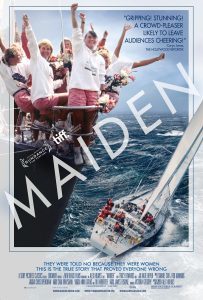



The post This Week in Movies with Meaning appeared first on Brent Marchant.



